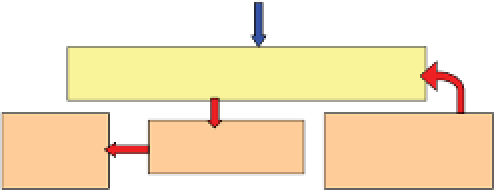Biomedical Engineering Reference
In-Depth Information
material parameters are with respect to common error sources
encountered in nanoindentation experiments, as well as to establish
appropriate algorithms to alleviate and smooth data fluctuations.
Different indenters (
e.g.
pyramidal, conical, spherical) can be used for
different systems, and the careful use of plural indenters may help to
deduce more material parameters.
Film and substrate
elastoplastic properties,
multilayer and material
microstructure, interface
toughness, etc.
Shape factors of
P-
h
curve, hardness,
stiffness, indent
profile, crack
geometry, etc.
Forward
analysis
Established dimensionless relationships
among multiple most important variables
Determined
material
properties
Data measured from
nanoindentation
experiment
Iteration and error
minimization
Reverse analysis
Figure 6-10. Computational modeling of indentation: The general forward (blue) and
reverse (red) analysis algorithms, which allow the determination of the mechanical
properties of various material structures using instrumented indentation.
The theory established from computational modeling of indentation
must be closely tied with experiment, with theory both explaining
experimental findings and predicting phenomena for experiments to
explore; in turn, the experiment could validate and improve the theory.
In use, several issues need to be paid special attention between
experimental data and theory, otherwise significant error may emerge.
91
Most indentation techniques proposed in literature are based on
homogeneous, isotropic (and identical tensile and compressive
behaviors), stress-free, power-law material, and assuming ideal indenter
geometry (and also the specimen surface must be sufficiently flat), which
may be referred to as the ideal model. An ideal model is also required for
the analysis of experimental indentation data, where phenomenological
material parameters may be extracted. If the real specimen does not
conform to the five basic assumptions of the ideal model, errors may
occur when one tries to use the indentation technique to extract
elastoplastic properties from the indentation test. Nevertheless, as shown








Search WWH ::

Custom Search